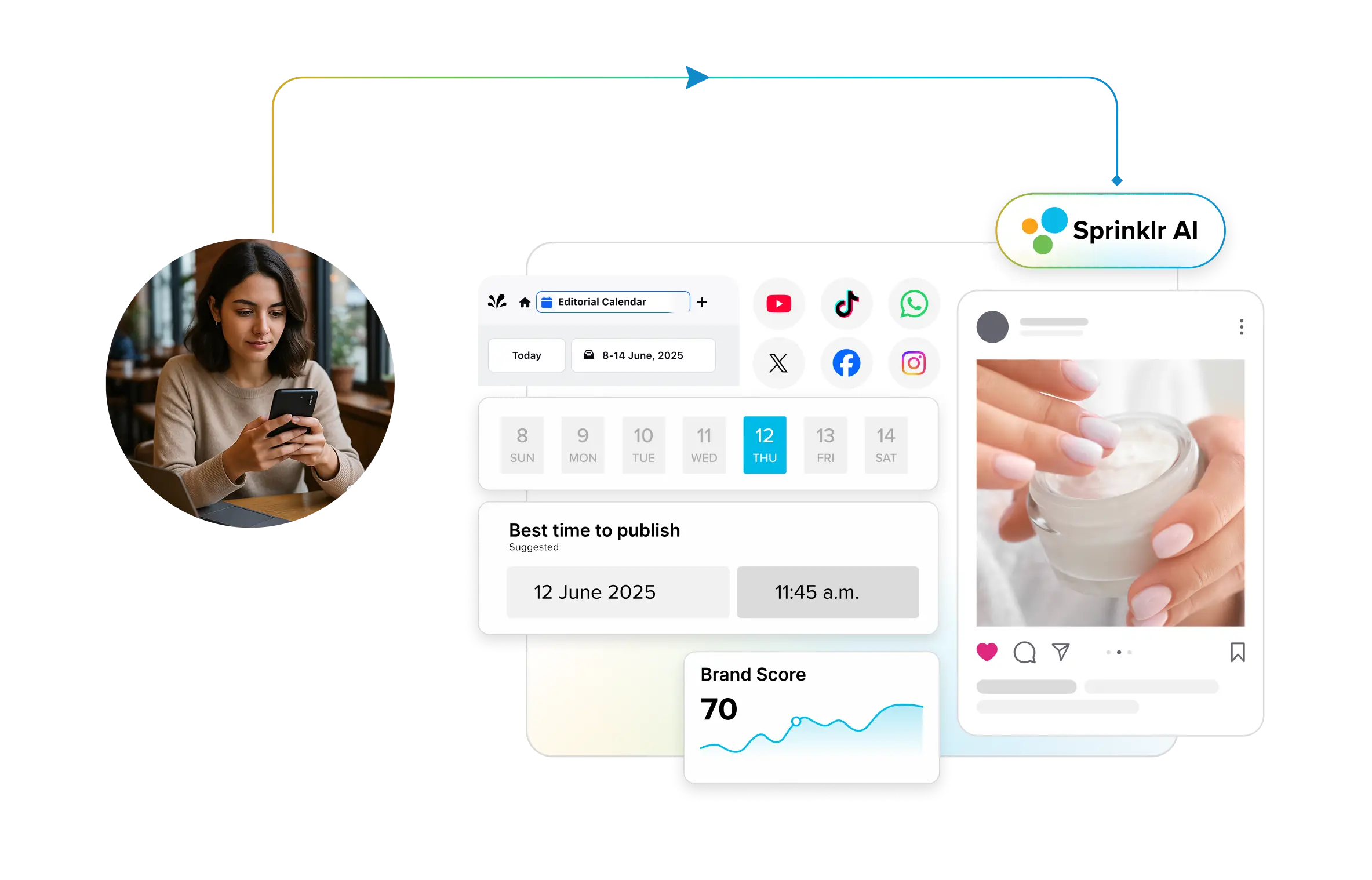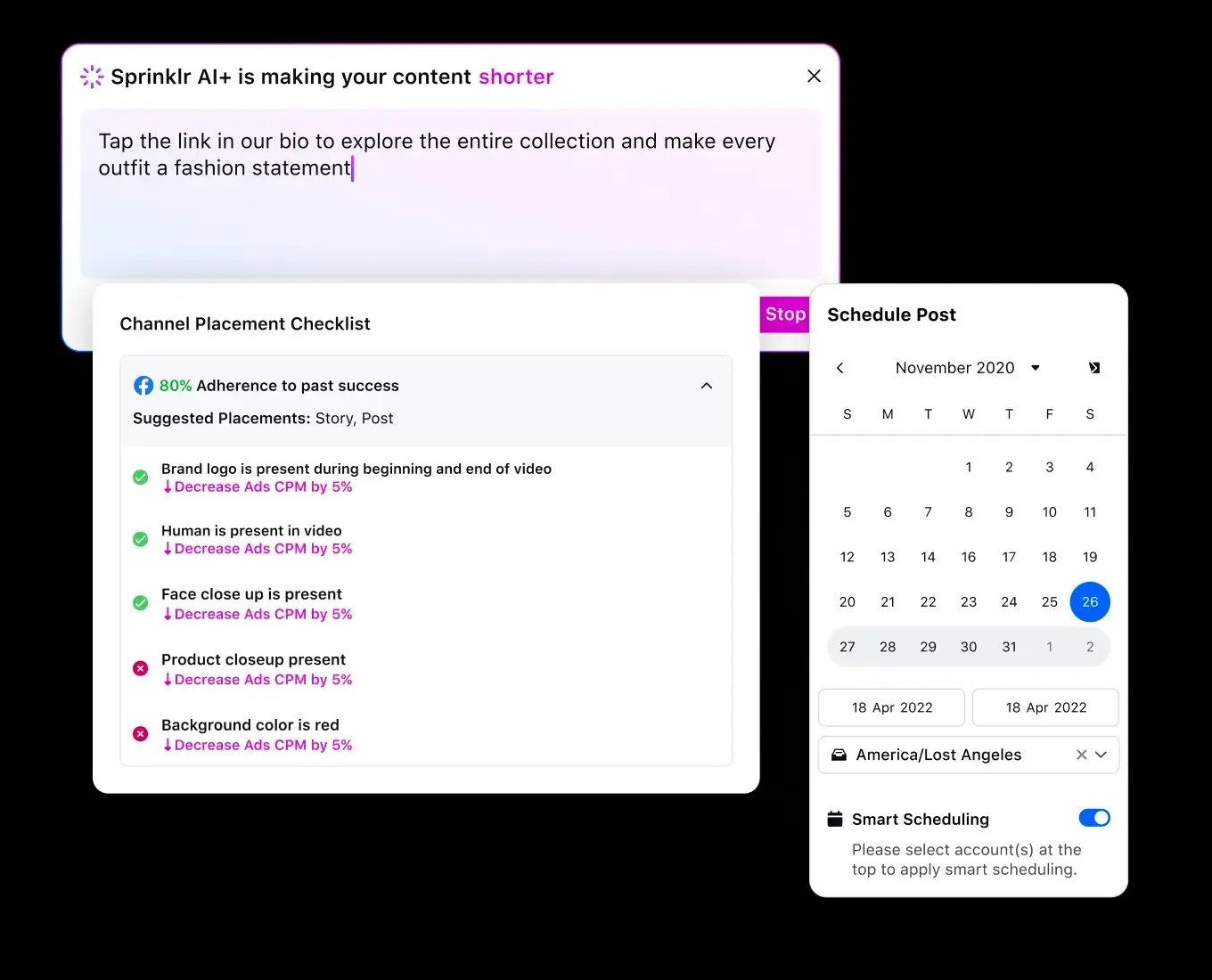The global leader in enterprise social media management
For over a decade, Sprinklr Social has helped the world’s biggest brands reimagine social media as a growth driver with a unified platform, industry-leading AI and enterprise-grade scale.

Social Media Strategy: How to Create An Effective Plan
Imagine your brand’s story reaching millions, engaging customers where they are, and turning followers into loyal advocates. That’s the power of a well-executed social media strategy. It’s not just about posting content—it’s about strategically using every platform to build meaningful connections, drive action, and achieve real business growth.
In this guide, we’ll show you how to create a social media strategy that goes beyond the basics, one that aligns with your business goals, keeps your audience hooked, and keeps you ahead of your competition in 2025.
What is a social media strategy?
A social media strategy is a plan that outlines steps undertaken by brands and marketers to achieve larger business goals through social media. A well-defined social plan empowers teams to build effective social media campaigns, driving organic growth, brand perception, competitive advantage, and eventually increasing demand.

Key components of an effective social media strategy
There are 8 key components of an effective social media marketing strategy:
Goals and objectives: Define clear, measurable goals that align with your business objectives to ensure your social media efforts drive tangible results.
Audience research: Understand your target audience's interests, behaviors, and preferences to tailor your strategy and create relevant, engaging content.
Content strategy: Develop a content plan that provides value to your audience, ensuring consistency and variety across your social media platforms.
Platform selection: Choose the right platforms based on where your target audience spends most of their time and how they prefer to consume content.
Engagement strategies: Create plans to actively interact with your audience, encouraging conversations, building community, and fostering brand loyalty.
Analytics and metrics: Track key performance indicators (KPIs) to measure the success of your social media activities and adjust your strategy accordingly.
Schedule and frequency: Maintain a consistent posting schedule and determine the best times for your audience to maximize engagement and reach.
Budget and resources: Allocate resources wisely, considering both your budget for paid campaigns and the human resources needed for content creation and management.
9 steps to create a powerful social media strategy
Follow these 9 steps from day one to build a winning social media marketing strategy from scratch.
Step 1: Set SMART goals and objectives
Social media marketing strategy is rooted in goals and objectives, such as increasing brand awareness, engagement, conversion rate, or followership. Goals define your next steps as well as your key performance indicators (KPIs).
Morever, they should be SMART [specific, measurable, achievable, realistic, and time-bound]. Let’s learn how to approach common social goals.
Brand awareness
Brand awareness on social media is the degree to which consumers recognize and remember a brand through its social media presence or activities. It's more about creating a positive brand perception through:
- Consistent delivery of valuable content
- Meaningful audience engagement
- Consistent branding
- Strategic collaborations
Let's discuss how you can improve brand awareness.
- Focus on platforms where your audiences spend the most time.
- Limit your efforts to a few key platforms rather than trying to be everywhere at once.
- Use logos or watermarks to associate content with your brand.
- Implement a social media style guide to stand out on crowded platforms and build recall.
- Use signature taglines, slogans, and hashtags to reflect your brand message.
Lead generation
Social media leads are those showing interest in your products and services by interacting with them on social media. These potential customers express interest, typically by requesting a callback or submitting a contact form.
Take a cue from Wild, the popular natural deodorant brand. It regularly shares enticing deals, reviews and testimonials to demonstrate brand value to potential leads. According to Bizrate Insights, 91% of survey participants check at least one review before making a purchase decision.
Community building
A social media community is a group of people who come together online to share common interests and experiences. This can include forums, chat rooms, and social networking sites where members interact, support each other, and exchange information.
A thriving community drives meaningful connections, positive word of mouth and strong brand affinity. It can amplify your presence on social media and customer acquisition.
Step 2: Research your audience
The next step in the social media plan is to research your audience and uncover their demographics, behaviors, needs, and pain points.
This enables you to personalize your marketing campaigns, content, and ads that are relevant to your audience.
In fact, McKinsey found that 71% of consumers expect personalized experience from the companies, and 76% are left frustrated when they don't get them.
How to research your target audience
Quantitative research
It focuses on collecting measurable data, such as facts, figures, and statistics, that gives an overview of your audience segment.
The data incorporates social media demographics such as age, gender, location, and profession, behavioral insights such as online activities and buying habits.
Tools like Google Analytics and in-platform analytics can be used to conduct research and gather quantitative data.
Qualitative research
On the other hand, qualitative research focuses on non-numerical audience insights such as habits, preferences, and experiences.
The research can be conducted by analyzing reviews, feedback, interviews, survey responses, and FAQs.
Additionally, it explores psychographics such as their interests, opinions, and lifestyles through surveys, questionnaires, and feedback forms.
Unlock the power of real-time audience insights with Sprinklr
Sprinklr Insights combines both qualitative and quantitative research methods and offers a comprehensive understanding of customer behavior trends, and brand performance.
- Capture real-time audience feedback on products and services to reveal customer sentiment and preferences.
- Uncover demographics, interests, followed accounts, and brand affinity, giving a comprehensive view of who your audience is and how to engage them.

Step 3: Identify target platforms
With so many platforms but limited time and resources, it gets daunting to decide where to focus your efforts. Hence, platform selection becomes another crucial step in creating an effective social media strategy. Narrowing down your choices enables you to channelize efforts and minimize redundancy.
Factors to consider during platform selection:
1. Audience preferences: Each platform serves a unique purpose and appeals to specific audience demographics. So, segment your audience based on location, interest, and age, ensuring selected platforms cater to important segments.
2. Cross-platform synergy: Select platforms that compliment each other to create a more powerful and effective social media strategy. For instance, you can share visually striking product images and videos on Instagram. Then use Facebook's advanced targeting options to reach the Instagram followers with tailored ads.
3. Platform features and algorithms: Evaluate each platform's advertising capabilities, targeting options, and business features to see if they meet your needs. Also, decode platform algorithms and watch updates closely to pick the best brand fit.
4. Competitive analysis: Take inspiration from your social media competitors. Observe their platform mix, posting frequency, and engagement tactics, picking learnings and opportunities to adapt your approach.
Step 4: Determine brand voice and persona
Brand voice reflects the core values and mission of a brand, expressed through consistent tone, language, and style across all channels.
On the flip side is social media persona, which is all about adapting your brand voice according to your audience's expectations and platform dynamics.
In other words, brand voice is static while social media persona is dynamic. Together, they form a unique brand identity.
For instance, Harley-Davidson has a bold, rugged, and rebellious brand voice that resonates with its target audience who seek thrill, exploration, and freedom. Harley takes on a different persona on different platforms using different marketing tactics:
On Instagram: Visually striking storytelling with images, and videos that showcase riders’ adventurous moments.
On Twitter: Short and impactful interactions along with trend-based posts, motivational messages, or witty responses.
On Facebook: Long-form storytelling and interactive posts featuring riders overcoming weather challenges.
No matter what the persona, there’s always an undercurrent of thrill and adventure in Harley’s social media. This consistency wins trust and credibility in the saturated social market.
Quick tips to craft your voice and persona
- Define core values
- Example: If you're a beauty brand, your values might include inclusivity, diversity, empowerment, and confidence.
- Understand your target audiences, their preferences, and pain points.
- Example: Luxury shoppers might prefer sophisticated, elegant, and aspirational messaging.
- Select a few key personality traits that describe your brand’s personality.
- Example: High octane energy for Red Bull and calming vibes for Dove.
- Develop a memorable social media tone. It can be formal or casual, concise or descriptive.
- Example: “Punch your limits. Get a healthy body”.
- Create a social media style guide to ensure stylistic consistency across all channels. Typography, audio, color palette, filters, and effects should be well-defined and distinct.
- Adapt your voice based on real-time customer feedback and sentiment analysis. Rebrand and reset if you have to.
Step 5: Establish a content calendar
A social media content calendar is a timetable of when and where you'll publish your next content. It streamlines your social media content strategy by:
1. Keeping a steady content flow and engaging the audience. Streamlined communication between editorial, creative, and marketing teams for all content-related tasks, deadlines, and responsibilities.
2. Allowing content diversity that caters to different audience preferences and platforms.
How to establish a social media calendar
Use an omnichannel calendar tool or template
- Select social media scheduling tools that suit your team size, budget, and content needs.
- Make sure it integrates with other messaging platforms you use.
- Take tool demos before making your final choice.
Personalize your calendar
Adjust your calendar based on your requirements, including custom fields for different content formats:
- Blog posts: Keywords, URL slug, title, description, image.
- Podcast: Script link, interviewee information, thumbnail.
- Videos: Script link, captions, video files, thumbnail.
Additionally, mention publishing dates, stakeholders, and media links with every calendar entry.
Schedule your content
- Evaluate your team size and capabilities to determine how often to publish on different social platforms.
- Consider manageable frequency – prioritize quality over quantity.
- Fill your calendar with topics and realistic deadlines.
Generate content ideas
Brainstorm social media post ideas that appeal to your target audience and cater to your business goals. To create scroll-stopping content, consider the next steps.
Step 6: Partner with influencers
Influencers can play multiple roles in your social media strategy, namely:
1. Content creators: Influencers create authentic and engaging content that resonates with their followers who coincidentally are also your target audience. This amplifies your reach and engagement both.
2. Market launchers: If you're planning to penetrate a new market, influencers can introduce you to a wider, relevant audience, increasing your brand visibility.
3. Credibility winners: Influencer recommendations carry weight. So when they endorse your brand, it significantly boosts your credibility and goodwill.
4. Spotlight stoppers: Partnering with the right influencer can help create buzz around your brand. They champion social media trends, using the best tools and tactics to position your brand favorably.
Benefits aside, influencer marketing comes with a few caveats and best practices. Here they are:
Ignore vanity metrics: Select influencers with high engagement rates rather than high follower counts. These are the ones who drive conversations and conversions.
Pro tip: Social listening helps you locate people discussing your industry and brand and discover influential voices within your industry on different platforms.
Keep the communication clear: Be upfront about content deliverables, timelines, usage, rights, and costs for promotions. Transparency fosters trust and locks social media ROI.
Allow creative freedom: Don’t curb the influencer’s creativity with stringent brand guidelines. However, specify the outcome and core message you'd want to deliver.
Build long-term partnership: It fosters trust and drives brand recognition with the influencer's audience. Also, the influencer becomes more familiar with your brand, feel a sense of ownership and take responsibility for your campaign’s success.
Step 7: Schedule and publish content
Social media post scheduling means lining up content to be automatically posted at a specific time and date across various platforms. It automates posting to ensure consistent, timely content delivery, even during peak events or holidays.
To schedule posts, you can use in-platform scheduling features or third-party scheduling tools.
Native platforms allow free post scheduling. They offer specific features tailored to the platforms, like auto-scheduling during high-traffic times and best times to post.
Facebook: Facebook Page
Instagram: Facebook's Creator Studio, Meta Business Suite
Twitter: Twitter's TweetDeck (now integrated with X)
LinkedIn: LinkedIn Page
YouTube: YouTube studio
However, the scheduling features these native platforms offer are usually basic. They may lack advanced analytics, reporting, multi-platform scheduling, or bulk social media posting.
That's when third-party social scheduling tools step in.
- They allow multi-platform scheduling from a single tool.
- They offer additional features like advanced analytics, reporting, content curation, team collaboration, and post approvals.
- You can schedule multiple posts at once, which saves time for a social media plan.
Demo offer: Sprinklr's omnichannel publishing and engagement
Sprinklr's social publishing and engagement powered by AI helps brands schedule posts across 30+ social channels, plus:
- AI-recommended posting time, ensuring maximum engagement.
- Post preview and channel-specific customization.
- Editorial calendar with views of all scheduled posts, events, and campaigns.
- Stringent compliance with platform and region-specific guidelines.

Step 8: Amplify engagement
Social media engagement is a vital metric that reflects the effectiveness of your social media marketing strategy. It not only involves likes, comments, and shares, but includes quality interaction, reaction, and connection with content on various social platforms.
Meaning, it's a two-way street. A meaningful engagement happens when users actively participate in discussions, share personalized experiences, or contribute user-generated content (UGC). Meanwhile, you listen, acknowledge, and respond.
Proven engagement tactics to try:
1. Polls and surveys: Use them to spark conversations, crowdsource ideas, or simply entertain your audience.
2. User-generated content (UGC): Respond to UGC with likes, shares, and comments to build a strong bond with your audience.
3. Hashtag campaign: Use hashtags on social media to amplify brand awareness or set inspiring narratives.
4. Interactive contests: You can encourage your audience to participate in social media contests, quizzes, and giveaways. It creates excitement, engagement, and a sense of community.
Step 9: Monitor and optimize
Once you've implemented your social media strategy plan, it's important to track its performance. For that, you'll have to monitor your social media analytics, metrics, and performance.
Social media analytics is the collection of data and metrics that give you an idea of how your overall social media marketing is performing. Here’s how it helps:
- Spots trending platforms, topics, influencers, and content.
- Detects audience sentiment (positive, neutral, or negative) around your campaigns and brand in general.
- Pinpoints areas of improvement and drives data-led decision making.
What to monitor?
- Number of posts influencers created
- Number of interactions per post
- Engagement rates
- Influencer campaign performance
If your social media metrics report underperformance, do a root cause analysis and optimize for success.
Need more tools? Read 7 best social media analytics tools for 2025
How to implement social media strategies: 2 Case studies
Let’s dive into two powerful examples from brands that have successfully used innovative tactics to achieve their goals and engage with their audiences.
1. Nike
A notable example from 2024 is Nike's "Move to Zero" campaign. This campaign focused on sustainability and climate action, leveraging social media to engage a younger, environmentally conscious audience. Its key elements include:
- Augmented Reality (AR) integration: Nike used AR filters on Instagram and Snapchat, allowing users to visualize their carbon footprint and see how Nike's sustainable products could help reduce it. This interactive approach made the campaign highly engaging and educational.
- User-generated content: Nike encouraged customers to share their own sustainability stories and actions using the hashtag #MoveToZero. This not only increased engagement but also built a community around the brand's sustainability mission
- Influencer collaborations: Partnering with eco-conscious influencers and athletes, Nike amplified its message through authentic voices that resonated with their target audience. These influencers shared personal stories and tips on living sustainably, making the campaign more relatable and impactful.
💡 Key takeaway:
Recognize the power of:
- Community engagement
- Technology integration
- Influencer partnerships
2. Harley-Davidson
Historically speaking, Harley-Davidson’s social media strategy catered to an older userbase. When the brand wanted to make inroads into the younger demographic [18-35 year olds], it pivoted its social plan to focus more on Instagram advertising. For the first time, in order to reach younger men in Australia and New Zealand, Harley went for a series of illustrations and carousel ads on Instagram.
The vibe fit in with the visual nature of Instagram and caught the eye of young adventurers who appreciate the world through a visual lens. Resultantly, the ads reached 1.4 million men aged 18-35, over a period of two weeks and drove 8000 click-throughs to Harley’s website.
💡Key takeaway:
Recognize the power of:
- Platform alignment
- Targeted advertising
- Power of creative content
For more inspiration, check out 7 social media strategy examples and tips to implement them.
Power your social strategy with the right tools
A successful social media strategy isn’t just about creating content—it's about creating content that drives action and fosters meaningful connections. Whether you’re aiming to increase brand awareness, drive sales, or build customer loyalty, having a solid strategy in place is key. With the right approach and the right tools, your social media efforts can transform into powerful campaigns that deliver measurable results.
Sprinklr Social can be the engine behind your success. With its ability to monitor trends, track audience behavior, and manage content across 30+ platforms seamlessly, Sprinklr helps you craft data-driven, results-oriented strategies that elevate your brand’s social media presence. Let Sprinklr power your next great campaign and align your social media efforts with your broader marketing goals.









